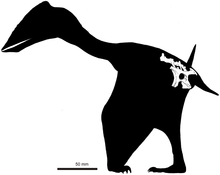Vectidraco
| Vectidraco | |
|---|---|

| |
| Holotype NHMUK PV R36621 | |
| Scientific classification | |
| Domain: | Eukaryota |
| Kingdom: | Animalia |
| Phylum: | Chordata |
| Order: | †Pterosauria |
| Suborder: | †Pterodactyloidea |
| Family: | †Tapejaridae |
| Subfamily: | † Tapejarinae
|
| Genus: | †Vectidraco Naish et al., 2013 |
| Type species | |
| †Vectidraco daisymorrisae Naish et al., 2013
| |
Vectidraco (meaning "dragon from the
Discovery and naming
In November 2008, Daisy Morris of

A scientific paper was published in 2013 about the find in the
The only known specimen,
Description

Vectidraco is a relatively small pterosaur. The pelvis is four centimetres long as preserved. Vectidraco's wingspan was estimated at seventy-five centimetres, its total body length at thirty-five centimetres. In view of its affinities, the describing authors assumed it was a toothless form, featuring a crest on its snout.[3]
Several unique derived traits,
Damage to the ilium shows the presence of camellate bone, internal air chambers. Also all the preserved vertebrae are pneumatised.[3]
Classification
Vectidraco was assigned to the
| Tapejaromorpha |
| ||||||||||||||||||||||||||||||||||||||||||||||||||||||||||||||||||
See also
References
- ^ a b "Isle of Wight girl Daisy Morris has flying prehistoric beast named after her". BBC News. 20 March 2013. Retrieved 22 March 2013.
- ^ "Schoolgirl discovers fossil of flying dinosaur on beach". 20 March 2013.
- ^ PMID 23526986.
- ^ "Dinosaur Discovery Girl, Daisy Morris, A 'Fascinating And Unique Girl'". Huffington Post UK. 21 March 2013.
- PMID 29534059.
- ISSN 0195-6671.
